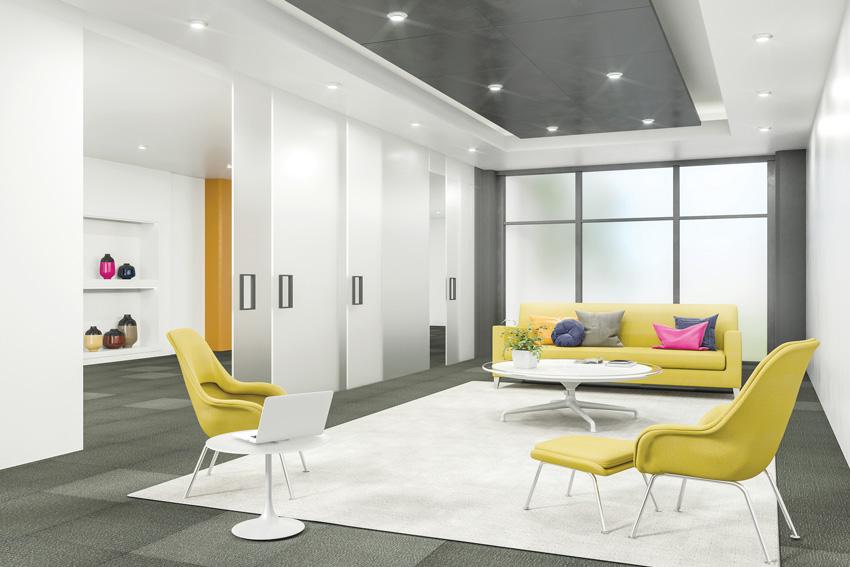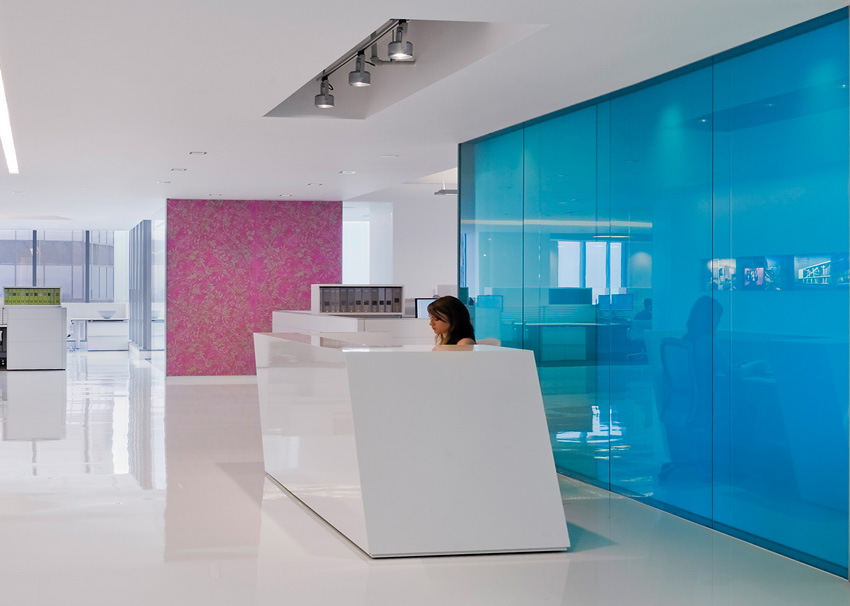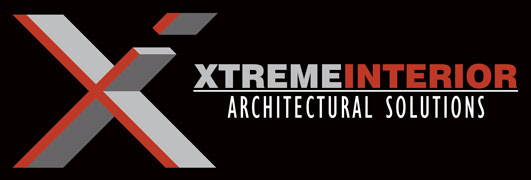Interior Motives
Interior Glass: Form and Function
The right interior glass creates value for architects and designers by offering capabilities ordinary glass doesn’t—from clarity and light control via low-iron glass to privacy and security via acid-etch glass. A question many architects and designers have is: How do I incorporate glass into my space and still provide privacy?
Architects and designers know that glass has value beyond aesthetics. Numerous studies have demonstrated how much better we function when we have access to natural light and views to the outside, furthering the idea discussed earlier related to biophilia. Incorporating interior glass means many occupants enjoy that benefit, not just the people on the perimeter.
Additionally, interior glass creates a more collaborative, engaging environment where people can maintain a visual, social connection. It also provides a blank canvas to paint/create inspiration and add color or texture, via back-painted glass or company branding, without blocking off spaces or limiting the footprint.
If a building exterior is made up of high-performance, low-E coated glass, the light that’s coming into interior spaces brings added value because the solar heat gain is better controlled. That means the natural light passing through strategically located interior glass is not going to bring unwanted heat gain or excessive glare.
Open office plans continue to be very popular; however, architects and designers can create the best of both worlds—open and private—by customizing the space. The right coated, painted, or acid-etched glass could be the perfect answer to keep the open feel and view while incorporating privacy elements via partitions that can incorporate laminated glass to reduce noise distractions or silkscreen gradient patterns that provide a good mix of light and privacy.
Types of Glass Products to Bring in the Light
Different types of glass products serve different purposes in terms of design and performance.
Clear low-iron glass on walls, partitions, tables, stairs, and more allows architects and designers to create spaces that pull light through interiors with exceptional clarity. The latest clear low-iron glass offers very high light transmission and appears color-neutral clear to the edge, reducing the green tint that often accompanies standard glass formulations.
Designers and architects choose this type of glass to flood interiors with natural light and create spaces that feel bright, open, and boundless. Applications are many, including frameless enclosures, walls and partitions, entranceways, display cases, tables, railings, and more—anywhere neutral color and clarity count.
Tom Daly, owner of Oasis Shower Doors, New England’s largest shower door company, says, “Low-iron glass allows natural light to pass through with remarkable clarity and brilliance that is perfect for shower applications, retail, and hospitality settings. Customers want true color transmission without the green tint from standard glass.”
Expanding on this, Sarah Wansack, interiors segment manager, Guardian Glass, says, “Low-iron glass is increasing in use for frameless applications such as shower enclosures and office partitions. It helps create uninterrupted views in office design and reduces the greenish cast of standard float glass for enhanced clarity. We’re also seeing more acid-etched glass in those applications when more privacy is required. Acid-etched glass is a happy medium, keeping the look and allowing for even dispersion of light—spaces seem to glow from within, especially when using low-iron glass—while adding some separation. This product is also durable and fingerprint resistant, an added bonus for upkeep.”
Specialized finishes , such as a satin-smooth, translucent finish used on clear glass, can bring brighter translucence to acid-etched glass for interior applications, obscuring the view through the glass while maintaining a high level of light transmittance, providing beauty, light, and privacy in one solution. By providing visual and tactile interest, and offering privacy while still welcoming abundant light, architects and designers may choose this type of finish to create unforgettable settings, and once installed, it should ideally retain its elegance and ease of care. One manufacturer’s proprietary product offers higher light transmission, more uniform light diffusion, and superior color neutrality via low-iron glass. Because it has a silky-smooth surface that resists smudges and fingerprints, this finish is easy to maintain using standard, nonabrasive products. The product can be cut-to-size, bent, screen printed, and fabricated for commercial exteriors.
Architects and designers use this type of specialized finish to make visually striking and memorable doors and moveable walls, partitions and panel systems, tabletops, stairways, shower enclosures, windows, and more. It brings depth and sophistication while incorporating privacy with light in a variety of commercial applications, including offices, retail settings, hospitality, and health-care environments. Use it on its own as a monolithic glass, or it can be fabricated into an insulated glass unit that includes performance glazing for added thermal insulation or solar control. Among the features to look for include its ability to be cut to size, heat treated, bent, screen printed, laminated, drilled, notched, and polished.

Image courtesy of Guardian Glass
By providing visual and tactile interest, and offering privacy while still welcoming abundant light, architects and designers may choose satin-smooth, translucent finishes for interior applications to create inviting, comfortable, unforgettable settings.
Decorative coated glass is another glass product available on the market that was created using a proprietary coating system and is a high-opacity, smooth glass with a uniform finish ideal for back-painted applications in the workplace, ranging from whiteboards to backsplashes. Both durable and eye-catching, its tempered quality ensures it can define spaces for years to come.
Other Interior Glass: Laminated Glass
Laminated glass in another choice. Its benefits include its ability to block harmful ultraviolet rays, which protects home, office furnishings, and artwork from fading and damage. You can use an accent color as a design statement or to delineate an area or function of a space using laminated glass.
Laminated glass can control sound, reducing interior noise levels and keeping inside conversations private. Laminated glass can also enhance the acoustic properties of a room, reducing echoes, improving sound quality, and insulating against sound passing through walls to prevent noisy outside environments from disturbing occupants.

Photo courtesy of Gensler Architects
The benefits of laminated glass include its ability to block harmful ultraviolet rays as well as incorporate accent colors for space delineation and interior noise control.
Conclusion
With recent statistics asserting that we spend approximately 87 percent of our time indoors, it is no surprise that great attention is being paid to creating interior spaces that will enhance our everyday lives. Manufacturers are paying attention, and now more than ever, they are making great strides in developing new, advanced products that can boost the look, feel, and performance of the indoor environment—everywhere from single-family homes, multifamily dwellings, workplaces, health-care facilities, schools—you name it.
As we’ve seen, interior design strategies can take many shapes and forms, and the next big thing is always on the horizon. From bringing nature into the mix or enhancing protective properties to experimenting with colors, textures, patterns, and light, there really is no limit to the possibilities for enhancing occupant satisfaction and building performance. The innovative products and systems examined in this course are just a few examples of the latest solutions available to help architects and designers find creative ways to take their interior projects to the next level.

|

|

|
Notice

www.c-sgroup.com/acrovyn-by-design

www.guardianglass.com

www.xtremeias.com








